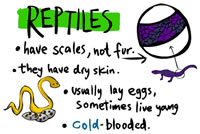Difference between Reptiles and Amphibians
Key difference: Reptile and amphibian are distantly related to each other; hence both are ectothermic, vertebrates and have three-chambered heart. They main difference between reptiles and amphibians are that reptiles live on land, whereas amphibians live on both land and water.
 Reptile and amphibian are distantly related to each other; hence they also have a number of similarities. They both are ectothermic, which means that they are cold-blooded. They are also vertebrates, i.e. they have backbones. With the exception of crocodiles and some other lizards, almost all of the reptiles and amphibians have a three-chambered heart.
Reptile and amphibian are distantly related to each other; hence they also have a number of similarities. They both are ectothermic, which means that they are cold-blooded. They are also vertebrates, i.e. they have backbones. With the exception of crocodiles and some other lizards, almost all of the reptiles and amphibians have a three-chambered heart.
However, like all things reptiles and amphibians have their differences, as well. They main difference between reptiles and amphibians are that reptiles live on land, whereas amphibians live on both land and water. The word “Amphibian” is derived from the Ancient Greek term, “amphibious” which means “both kinds of life”. Amphibians live double lives, one in the water, where they are born with gills and one as they grow older and develop legs and lungs, which allow them to survive on land. Early amphibians were a crucial link from fish to terrestrial reptiles. They were the first animals to leave the sea and venture onto the land.

Reptiles, on the other hand, mainly live on land. Some reptiles, such as crocodiles, alligators, and various snakes do enter the water and spend time there; however, they do not live underwater and they do not need to venture into the water. They can easily survive on land alone, like thousands of other species of reptiles.
The word, reptiles means “to creep stealthily under cover of darkness.” Reptiles, in general, have dry, scaly skin; they breathe air through lungs, and usually lay eggs. Reptiles live on every continent except Antarctica and in varying conditions. Amphibians, on the other hand, are mainly found near fresh water sources, such as lakes, rivers, etc and/or in tropical area with abundant rainfalls and moist areas.
Detailed comparison between reptiles and amphibians:
|
|
Reptiles |
Amphibians |
|
Scientific classification |
Animalia – Chordata – Amniota – Reptilia |
Animalia – Chordata – Tetrapoda – Amphibia |
|
Species |
More than 6,500 known species of reptiles. Four main groups of reptiles:
|
About 5,500 known species of amphibians, divided into 3 main groups:
|
|
Description |
Reptiles are vertebrates; they have scaly skin that keeps their bodies from drying out. |
Amphibians are animals that live part of their lives in water and part on land. Amphibians are vertebrates, and are also ectothermic. |
|
Examples |
Snakes, alligators, crocodiles, tortoises, lizards, etc. |
Frogs, toads, salamanders, newts, and caecilians or blindworms. |
|
Body Metabolism |
Ectothermic (Cold-blooded) – must bask in the sun or find a warm spot to get warm and become active, and they must find shade or a cool spot to cool off. |
Ectothermic (Cold-blooded) – cannot regulate their own body heat, so they depend on warmth from sunlight to become warm and active. Or a cool spot to cool off. |
|
Skin covering |
Scales that can be hard or soft, large or small. Skin is found underneath the scales. |
Soft, moist skin that is protected by a slippery secretion of mucus. |
|
Method of Breathing |
Lungs |
Gills and lungs |
|
Heart structure |
3-chambered |
3-chambered |
|
Limbs |
Reptiles crawl or creep- as they have either weak short limbs or even no limbs. |
Short fore limbs and long hind limbs with five webbed digits. |
|
Eggs |
Amniotic egg. Eggs are hard and/or leathery and are laid on land or the reptiles keep eggs in their bodies until they hatch. |
The egg is typically surrounded by a transparent gelatinous covering containing mucoproteins and mucopolysaccharides. This covering absorbs water and gases, and swells considerably as it absorbs water. Eggs are usually, found in water or damp places. |
|
Birth |
Born on land and with strong instincts. Physically look similar to adult. Most mother reptiles leave the nest once the eggs are laid. The hatchlings are independent from the start, and must find their own food and shelter. |
Born in water or mushy land with gills and tails. Physically look very different than their adult counterparts. |
|
Development |
The hatchlings look physically similar to the adults. They grow in size but do not experience any metamorphosis. |
Young amphibians are called larvae, and as they develop, they change in body shape, diet, and lifestyle through metamorphosis. As they get older they develop lungs and legs. |
|
Defense |
Via claws, whipping tails and bites. Some species are venomous, such as Gila monster, beaded lizard, etc. |
Toxic secretions through skin and they bite. However, they don’t have any claws or nails. |
Image Courtesy: caitand.weebly.com, sheppardsoftware.com









Add new comment